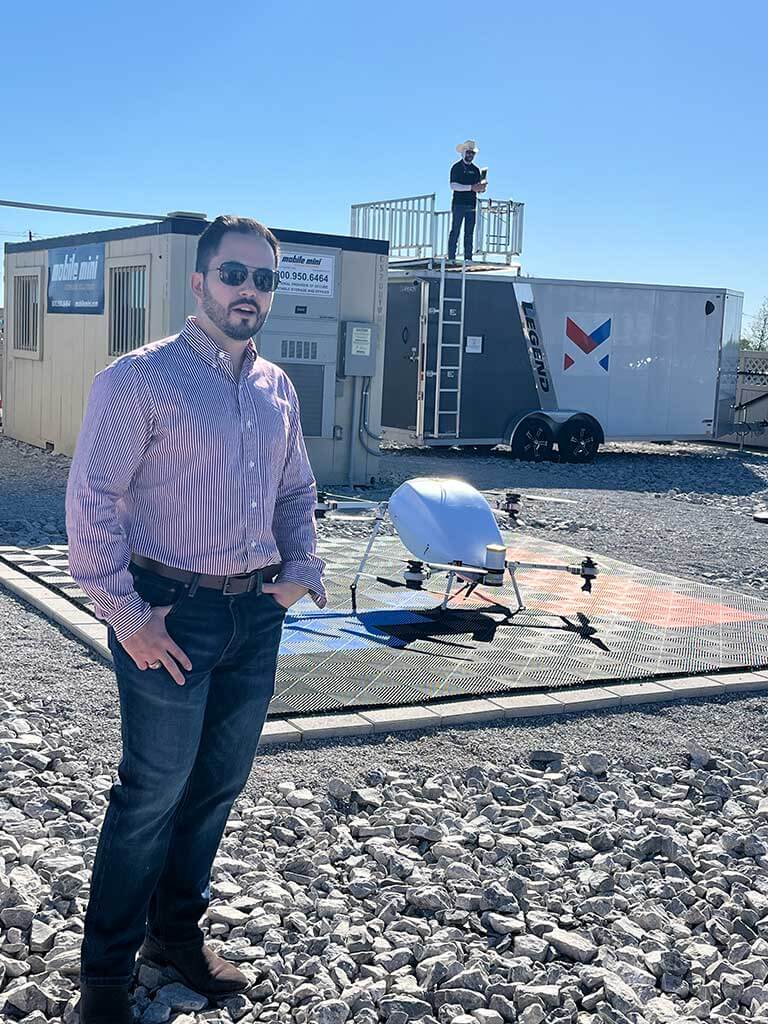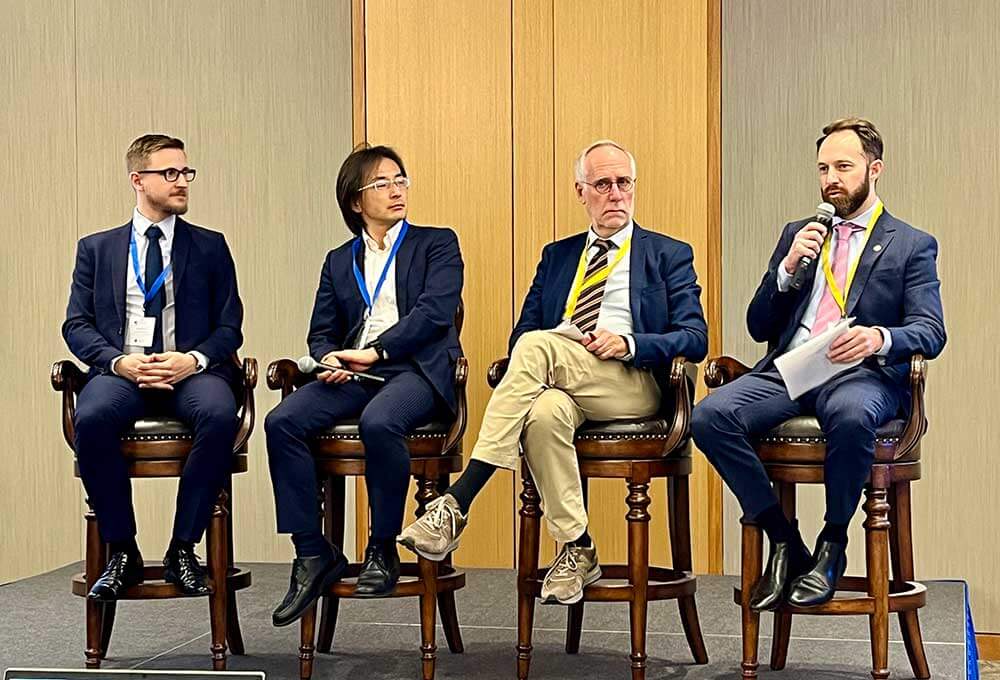From drone deliveries to long line linear critical infrastructure inspections, the integration of UAS into national airspaces continues to grow across various industries and economies. As it does, UAS Traffic Management (UTM) systems have emerged as a key enabler for sustainable and repeatable drone operations. To provide a comprehensive overview of the state of current global UTM development, experts at the Global UTM Association (GUTMA) created the soon-to-be-published (we hope!) UTM Ecosystems Readiness Index. The index aims to offer valuable insights into the strengths and weaknesses of various UTM ecosystems across different countries and regions. GUTMA provided a preview of its assessment at its end-of-year Harmonized Skies event. This article covers the highlights from that reveal and what we might expect to see in GUTMA’s final report.

Global Progress in UTM Development
A dedicated task force within GUTMA, in recognition of the need for a standardized method to evaluate UTM progress worldwide, developed the index. It analyzes six key dimensions: legislation, governance, strategy, operations, technology and market maturity. This approach allows for meaningful comparisons between diverse regions. It also helps identify best practices and areas for improvement in the rapidly evolving field of UTM. Here’s what we learned.
Europe: A Regulatory Pioneer
Europe has been at the forefront of developing regulatory frameworks for UAS operations. The European Union (EU) adopted regulations early on to facilitate commercial drone activities. Among these, U-Space, EU’s seminal UTM regulation, stands out as an exemplar for others to follow. These regulations have provided clear guidance for member states and industries to enable a unified approach across the region. However, challenges remain in translating these frameworks into widespread operational deployments.
One notable strength in Europe is its investment in research and development (R&D). Significant funding has been allocated to projects aimed at advancing UTM technologies and strategies, such as various iterations of the Gulf of Finland (GoF) trials. Despite this progress, frustration remains over the slow pace of commercial operations compared to other regions like North America.
North America: Operational Leadership
The United States leads in operational deployment of UTM systems. With real-world commercial drone operations involving UTM for strategic deconfliction already underway, such as at the Dallas-Fort Worth key site, the U.S. has demonstrated how public-private partnerships can drive innovation. The Federal Aviation Administration (FAA) has played a pivotal role in fostering collaboration between industry stakeholders and government agencies.
The recent focus in North America has been on enabling real-world applications such as drone deliveries and inspections, through regulatory beyond visual line of sight (BVLOS) waivers and its UTM Near Term Approval Process (NTAP). This practical approach has positioned the region as a leader in demonstrating the economic potential of UAS technologies.
Asia-Pacific: Public-Private Synergy
Japan exemplifies effective public-private collaboration in UTM development. Government ministries actively engage with private stakeholders to create a supportive environment for innovation. This cooperative model ensures that both regulatory frameworks and industry needs remain aligned.
Australia has also made significant strides by emphasizing market-oriented approaches. By analyzing market trends and projecting future needs, Australia has developed strategies that prioritize economic sustainability alongside technological advancement.
Africa and South America: Emerging Players
While Africa and South America are still developing their UTM ecosystems, there are promising signs of growth. These regions are leveraging lessons from global leaders to establish foundational frameworks that support future scalability. For example, pilot projects focusing on drone delivery services continue to lay the foundation for broader adoption.

Key Challenges in UTM Implementation
Each region reflects different levels of progress and approaches. When it comes to viable business operations globally, some common UTM implementation challenges exist across the board. These have hindered the full realization of global UTM systems.
- Regulatory Fragmentation: Different regions have adopted varying approaches to regulation. While Europe emphasizes risk-based frameworks, other regions like North America favor performance-based models. This lack of standardization complicates international operations for businesses who desire to operate globally.
- Economic Viability: Ensuring the financial sustainability of UTM ecosystems remains a significant hurdle. Many experts argue that initial public funding is essential to kickstart infrastructure development before transitioning to self-financing models.
- Technological Integration: The integration of advanced technologies such as automated airspace management tools is still in its infancy. Achieving interoperability between different systems is also crucial for global scalability.
- Market Uncertainty: The economic potential of drone services is not yet fully understood. Clearer insights into market demand are needed to guide investment decisions and policy development.
Best Practices for Building Sustainable UTM Ecosystems
In the face of uncertainty, one thing is clear: the development of UTM ecosystems requires collaboration between public and private stakeholders, robust technological infrastructure and economic foresight. Global insights and real-world examples provide a guide to best practices for creating sustainable UTM systems.
Public Funding as a Catalyst
Public funding plays a crucial role to jumpstart UTM ecosystems, especially in their early stages. This includes state support to finance initial infrastructure and services before transitioning to self-sustaining models. Financial support often flows from favorable regulation.
For instance, Australia has demonstrated the importance of public investment by aligning government strategies with industry needs. The Australian Department of Infrastructure developed a comprehensive regulatory roadmap and action plan to operationalize UTM systems over the next decade. This strategic alignment ensures that public funds are used effectively to support emerging drone services while preparing for future scalability.
Japan further exemplifies how government-led initiatives can drive innovation. Japanese ministries actively engage private stakeholders through consortiums and national projects, such as research on drone mobility solutions. This collaboration ensures that public investments address both regulatory requirements and market demands.
Focus on High-Volume Services
High-volume drone services, such as drone deliveries and eventually passenger transport, are critical to achieve financial sustainability in UTM ecosystems. These services operate at a high frequency and can generate a consistent revenue stream, and the scale needed, to sustain UTM systems and support ongoing operations and infrastructure costs.
Europe has tailored the regulatory framework to enable commercial drone operations. While implementation has been slower than anticipated, the focus on high-volume applications like logistics and urban air mobility (UAM) reflects a long-term strategy for economic viability.
Performance-Based Regulations
Flexible, performance-based regulations foster innovation. They allow operators to experiment with new technologies and business models without being constrained by overly prescriptive rules.
The U.S. has adopted a performance-based regulatory framework. Similarly, in Australia, regulators have adopted interim provisions to enable real-world operations while refining long-term regulations. This approach allows for agile adjustments based on operational feedback and ensures that regulations evolve alongside technological advancements.
Conversely, Europe’s risk-based regulatory framework has faced criticism for its slower pace in enabling commercial operations. Experts suggest that adopting performance-oriented regulations could accelerate market development by providing clearer pathways and the flexibility needed for businesses to scale.
Coordinated Governance
Effective governance involves seamless collaboration between public agencies and private companies to align policies with industry needs.
Japan stands out as a model of public-private synergy. The Japanese government actively invites private stakeholders to participate in working groups and national initiatives to foster a culture of cooperation. This collaborative approach ensures that regulations remain both practical and forward-looking.
Similarly, Switzerland utilizes an inclusive governance model. Public authorities have worked closely with private entities to develop successful UTM frameworks tailored to local needs.
Market-Oriented Strategies
Understanding market dynamics is essential for making informed decisions about UTM development. Countries that prioritize market analysis can better anticipate future demands and allocate resources accordingly.
Australia excels in this area by using market-oriented tools to project future needs and inform policy decisions. Australian regulators assess market trends over 5-, 10-, and 15-year horizons to ensure that UTM systems are designed with long-term sustainability in mind.
In contrast, some regions lack comprehensive market strategies. This leads to uncertainty about the economic potential of drone services. Experts recommend using tools like market sizing and economic modeling to bridge this gap.
Future Directions
As the drone industry continues to mature, the focus will likewise shift from basic operational capabilities to enabling large-scale commercial applications. This evolution requires:
- Global Standardization: Harmonizing regulations across regions will facilitate international operations and reduce compliance costs.
- Advanced Technologies: Investments in artificial intelligence (AI), machine learning (ML), and real-time data analytics will enhance airspace management capabilities.
- Economic Modeling: Comprehensive market analyses will help stakeholders understand demand dynamics and make informed decisions.
- Public Awareness: Building societal acceptance for drones through transparent communication about safety measures and benefits is critical.

UTM: Unlocking the Potential of Drones
The development of UTM systems is not just about creating tools for drone operations – it’s about building a comprehensive framework that supports commercial scalability.
The current state of UTM reflects both remarkable progress and highlights gaps that need filling. Regions like Europe and North America have set benchmarks in regulation and operations, while Asia-Pacific countries have demonstrated the power of close collaboration. Emerging markets in Africa and South America are beacons of potential for global UTM expansion.
At its core, a robust UTM ecosystem encompasses all the components required to manage drone operations effectively. These include regulations, governance structures, technological infrastructure and economic frameworks. A sustainable UTM ecosystem must integrate public and private stakeholders to enable seamless cooperation between regulators, service providers, and end-users. To unlock the full potential of drones, these groups must collaboratively address critical dimensions such as legislation, governance, operational readiness, technology adoption and market maturity.
By learning from each other’s successes and failures, countries can build their own robust UTM ecosystems to boost the drone industry’s upward trajectory, while ensuring safety and efficiency in the skies above us all.
Several best UTM practices have emerged from global experiences:
- Public Funding as a Catalyst: Initial government investment can accelerate infrastructure development and reduce barriers for private stakeholders.
- Focus on High-Volume Services: Drone delivery and passenger transport services offer the scale needed to make UTM ecosystems financially viable.
- Performance-Based Regulations: Flexible regulatory frameworks that focus on outcomes rather than prescriptive requirements can foster innovation.
- Coordinated Governance: Collaboration between public agencies and private companies ensures that policies are practical and aligned with industry needs.

